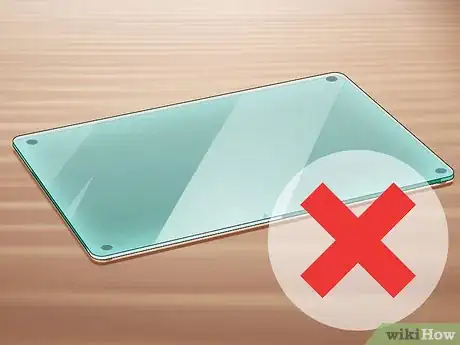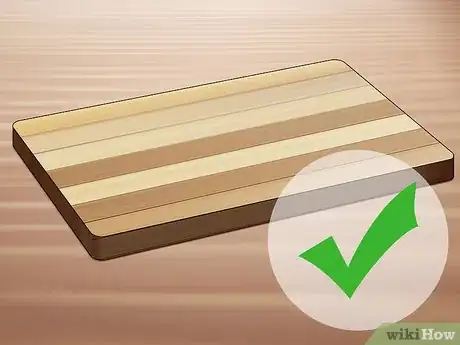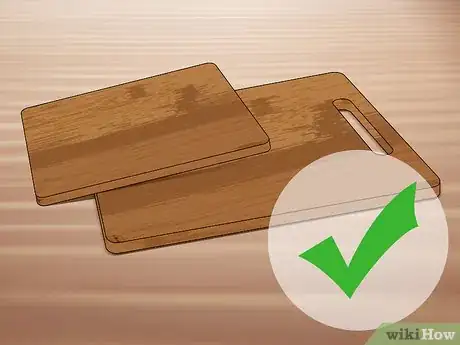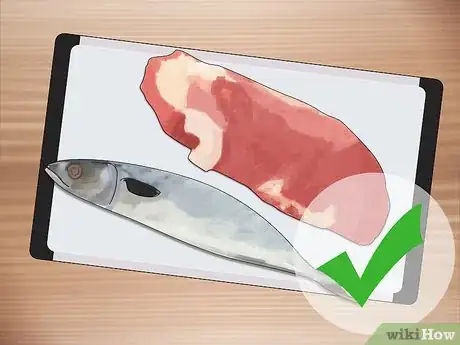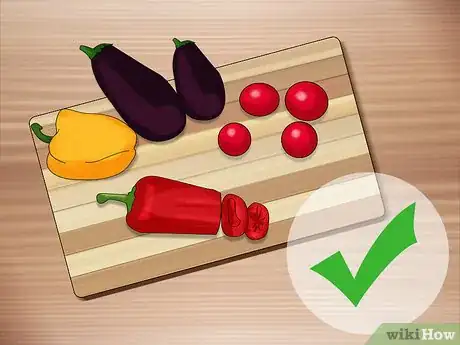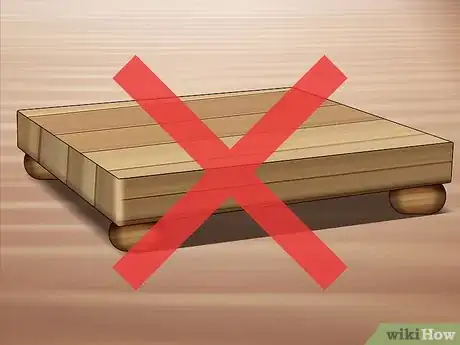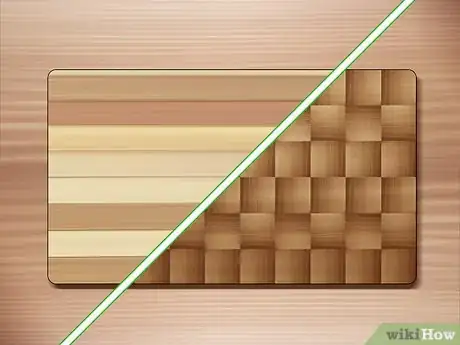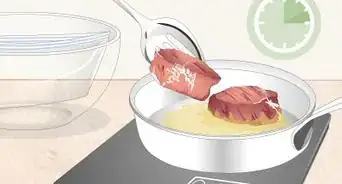This article was co-authored by Jerran Boyer. Chef Jerran Boyer is a Nutrition-Focused Professional Chef and the CEO of Health Nut Chefs. Chef Jerran has over 20 years of experience as a private chef. She and her team specialize in providing healthy, fresh-prepared meals designed with each client’s taste and dietary needs in mind. She and her team offer both personal, part-time chef services and private, full-time chef services in New York, New Jersey, and the Los Angeles area. Chef Jerran received her BS in Business Administration from the University of South Florida, a degree in Culinary Arts from Florida Culinary Institute, and a Plant-Based Nutrition Certificate through Cornell University.
This article has been viewed 34,316 times.
Cutting boards come in a variety of materials—including glass, plastic, wood, and bamboo—but not all of these materials are created equal. In order for you to select the best cutting board, you must first choose the right material. In fact, you may even want to select two different cutting boards to use for different foods. In addition, there are some other factors to consider, such as size, type of grain, and level of maintenance required. By reviewing all of these options, you can select the perfect cutting board for your kitchen.
Steps
Choosing the Right Material
-
1Avoid glass. Glass cutting boards are a popular choice because they look nice in your kitchen. However, glass cutting boards have been shown to dull brand new kitchen knives in as little as 10 strokes. If you happen to have a glass cutting board, use it as a serving platter or cheese tray instead.[1]
- Other hard cutting board materials—like marble, granite, ceramic, and composite—can do similar damage to your knives, and should be avoided.
-
2Choose the right kind of plastic. Plastic cutting boards can be a great option. They are affordable, easy to clean, and safe for knives. However, not all plastic boards are the same![2]
- Avoid slick or smooth plastic, as this can cause knives to slip.
- Acrylic plastic boards can do almost as much damage to your knives as glass.
- Plastic cutting boards made of polyethylene or polypropylene are the best choice.
- A good choice is the Oxo Carving and Cutting Board for $24.99 (available at Bed, Bath, and Beyond, Sur la Table, and JC Penny).
Advertisement -
3Opt for wood. Wood cutting boards are the classic choice. These are far and away the most popular cutting boards for chefs and amateurs alike. Wood cutting boards are lovely, they last a long time, and they are great for your knives. Wood cutting boards are available in many types of wood, including oak, maple, and teak.
- Teak is a great option because it absorbs very little liquid, so it will take longer for the board to wear out.
- A good choice is the Proteak Edge Grain Teak Cutting Board for $92.59 (available on Amazon).
-
4Choose a bamboo board for sustainability. Bamboo cutting boards are very similar to wood boards. They last a long time, they are wonderful for your knives, and they are lovely to have out in your home. Additionally, bamboo boards are a sustainable, environmentally friendly choice, since bamboo is a fast-growing, highly renewable resource.[3]
- Bamboo boards are lighter in weight than wood boards.
- Bamboo boards don’t need to be oiled as often as wood boards.
- A good choice is the Totally Bamboo 20-7930 3-Piece Cutting Board Set for $15 (on Amazon).
Using Different Boards for Different Foods
-
1Select two cutting boards. Most chefs advocate for keeping at least two cutting boards at home: one wood and one plastic. This enables you to keep raw protein away from fruits and vegetables and maintain a sanitary work environment.[4]
-
2Use plastic boards for meat or fish. Bacteria from raw meat are best kept away from your fruits and vegetables. As such, it is best to use a separate cutting board for these foods. Additionally, the oils from fish can sometimes seep into wood fibers and leave a lasting smell on your wood cutting boards. Consider keeping a plastic cutting board at home to use for meat and fish.[5]
- A thin plastic cutting board can be placed on top of a wood board for ease of use.
-
3Select wood or bamboo for produce. Wood (or bamboo) cutting boards are the best choice for fruits and vegetables. These boards are built to last, and will also help extend the life of your knives.[6]
- Cooked meats are also safe to carve on your wood (or bamboo) cutting board.
Considering Other Factors
-
1Avoid cutting boards with “feet.” You want to get the most out of your cutting board, and this means being about to use both sides. Stay away from cutting boards that have “feet” on the bottom, or are otherwise not reversible. By using both sides, you essentially get two cutting boards in one.[7]
-
2Select the right size. Experts chefs suggest choosing a cutting board that is 15 by 20 inches (38 to 50 cm) in size. This gives you plenty of room to work safely and effectively as you cut.[8]
-
3Choose between end-grain or edge-grain. When opting for a wood or bamboo cutting board, you will have the opportunity to choose end-grain (meaning the board is grafted from many small pieces of wood in a checkerboard pattern) or edge-grain (meaning the strips of wood are laid side-by-side).
-
4Consider the level of maintenance required. By and large, wood cutting boards are the best choice for durability, beauty, and protection of your knives (with bamboo as a close second). However, wood (or bamboo) cutting boards can be cumbersome to wash, and they need to be oiled regularly. Plastic cutting boards, on the other hand, are often dishwasher safe and require no additional maintenance. If you do not have the time to regularly maintain your cutting board, plastic may be a better choice for you.[12]
Community Q&A
-
QuestionWhat is an eco-friendly choice for a cutting board?
 wikiHow Staff EditorThis answer was written by one of our trained team of researchers who validated it for accuracy and comprehensiveness.
wikiHow Staff EditorThis answer was written by one of our trained team of researchers who validated it for accuracy and comprehensiveness.
Staff Answer wikiHow Staff EditorStaff AnswerAn environmentally friendly choice for cutting boards would be to choose wooden ones, either bamboo or hard wood from a sustainable forestry source. Avoid getting a plastic board, both because it's a good idea to reduce plastics in your life and also because it is not as safe as wooden boards, which have natural antibacterial properties. Moreover, wooden boards don't get the deep cut marks that plastic boards can get, so they last longer and are less likely to harbor bacteria or introduce plastic into your food.
wikiHow Staff EditorStaff AnswerAn environmentally friendly choice for cutting boards would be to choose wooden ones, either bamboo or hard wood from a sustainable forestry source. Avoid getting a plastic board, both because it's a good idea to reduce plastics in your life and also because it is not as safe as wooden boards, which have natural antibacterial properties. Moreover, wooden boards don't get the deep cut marks that plastic boards can get, so they last longer and are less likely to harbor bacteria or introduce plastic into your food.
Expert Interview
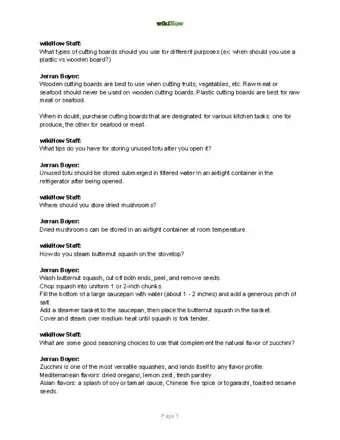
Thanks for reading our article! If you'd like to learn more about kitchen tools, check out our in-depth interview with Jerran Boyer.
References
- ↑ http://www.chicagotribune.com/lifestyles/sc-cons-cutting-board-solutions-0407-20160407-story.html
- ↑ http://www.chicagotribune.com/lifestyles/sc-cons-cutting-board-solutions-0407-20160407-story.html
- ↑ http://www.chicagotribune.com/lifestyles/sc-cons-cutting-board-solutions-0407-20160407-story.html
- ↑ http://www.huffingtonpost.com/2012/03/12/cutting-boards-to-avoid_n_1335613.html
- ↑ http://www.chicagotribune.com/lifestyles/sc-cons-cutting-board-solutions-0407-20160407-story.html
- ↑ http://www.huffingtonpost.com/2012/03/12/cutting-boards-to-avoid_n_1335613.html
- ↑ http://www.chicagotribune.com/lifestyles/sc-cons-cutting-board-solutions-0407-20160407-story.html
- ↑ http://www.chicagotribune.com/lifestyles/sc-cons-cutting-board-solutions-0407-20160407-story.html
- ↑ http://www.chicagotribune.com/lifestyles/sc-cons-cutting-board-solutions-0407-20160407-story.html
